The 2021 Emerging Leader in Atomic Spectroscopy Award
This year’s Atomic Spectroscopy Award recipient is L. Robert Baker, whose research focuses on time-resolved, ultrafast X-ray spectroscopy and nonlinear optics for understanding interfacial charge transfer and chemical reactions at surfaces.
L. Robert Baker is an associate professor at The Ohio State University in the Department of Chemistry and Biochemistry. His research focuses on ultrafast, time-resolved X-ray spectroscopy and nonlinear optics for understanding interfacial charge transfer and chemical reactions at surfaces. He is the winner of the 2021 Emerging Leader in Atomic Spectroscopy Award. The award was presented to Baker on February 24 at the Spectroscopy Virtual Symposium, “Atomic Spectroscopy in Practice,” where he gave a plenary lecture. The Spectroscopy Emerging Leader in Atomic Spectroscopy Award recognizes the achievements and aspirations of a talented young atomic spectroscopist who has made strides early in his or her career toward the advancement of atomic spectroscopy techniques and applications. The winner must be within 10 years of receiving his or her highest academic degree in the year the award is granted, and the winner is chosen by an independent committee.
Atomic spectroscopy award recipient, L. Robert Baker.
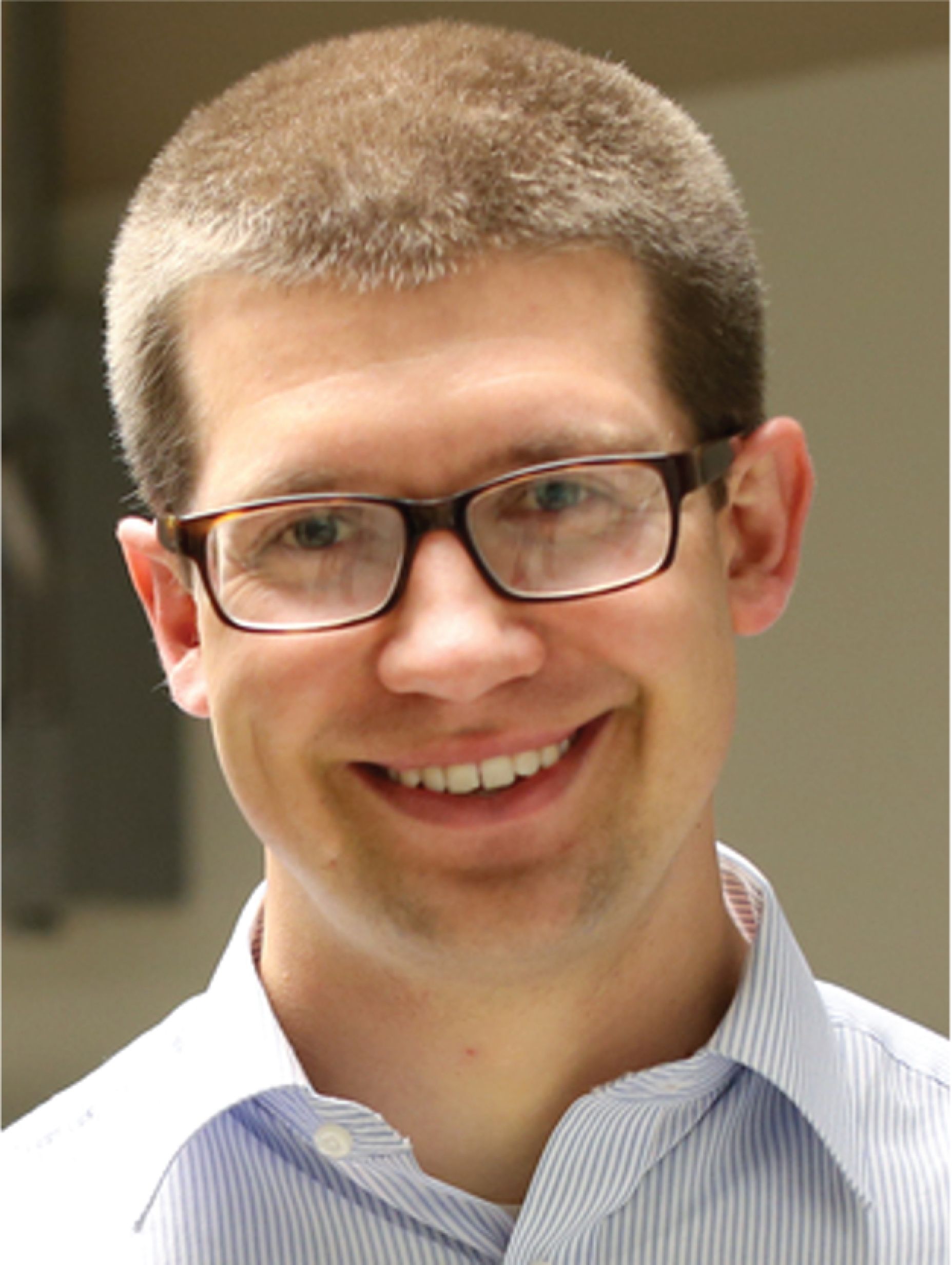
Baker earned his undergraduate BS degree in chemistry and his MS in physical chemistry from Brigham Young University and received his PhD in 2012 in physical chemistry from the University of California, Berkeley, under Professor Gabor A. Somorjai. His thesis title was, “Charge Transfer and Catalysis at the Oxide–Metal Interface.” Following postdoctoral research at the University of California, Berkeley (mentored by Professor Stephen R. Leone), he then became an assistant professor at The Ohio State University in 2014. In 2019, he was appointed an associate professor of chemistry. He serves as a principal investigator of the NSF National eXtreme Ultrafast Science (NeXUS) facility. His awards include the Camille Dreyfus Teacher–Scholar Award, the Air Force Office of Scientific Research Young Investigator Award, a Department of Energy Early Career Award, and the Young Innovator Award in NanoEnergy.
With an h-index of 18, and an i10 index of 24, and over 1200 citations in Google Scholar, Baker has published research in high-impact journals, such as Journal of Physical Chemistry, Letters, Nano Letters, Chemical Sciences, Journal of Physical Chemistry C., ACS Catalysis, and Chemical Reviews. Baker’s research explores the physics and chemistry of transition metal oxide catalyst surfaces using ultrafast extreme ultraviolet refection-adsorption spectroscopy. He has used this technique to study the surfaces of single and mixed metal oxides. Such materials are used in electron transfer, energy conversion, electrochemistry, and catalysis.
Summary of Research Work
As a PhD student at the University of California, Berkeley, Baker worked with Professor Somorjai using sum frequency generation (SFG) vibrational spectroscopy combined with nanomaterials chemistry to investigate heterogeneous catalytic reactions on metal oxide surfaces. Following his PhD studies, he undertook postdoctoral work with Professor Leone where he learned high harmonic transient absorption spectroscopy for studying ultrafast electron dynamics. This technique is based on laser-driven high harmonic generation, where near-infrared (IR) photons from an ultrafast laser pulse are upconverted to high energy photons that can reach even into the soft X-ray region of the electromagnetic spectrum. This technique provides extremely fast laser pulses in the extreme ultraviolet (XUV) and X-ray spectral regions. Such capabilities provide time-resolved and atom-specific information when performing transient adsorption experiments.
FIGURE 1: Baker engaging graduate students and colleagues during the Ohio State Industry Day poster session on August 10, 2020. This day advocates for graduate students in various department to interact with industry liaisons and faculty.
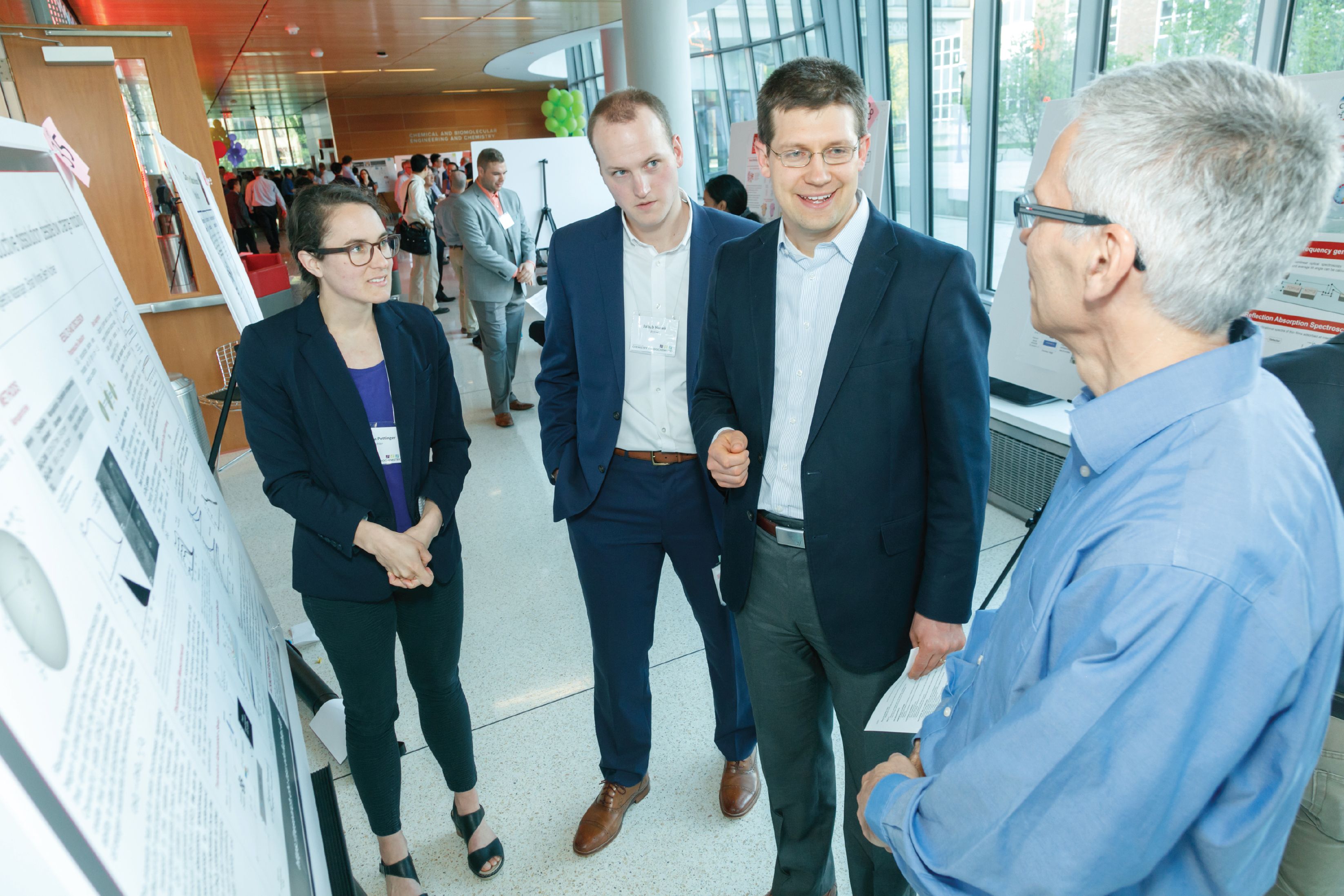
After Baker moved to The Ohio State University in 2014, he developed a new version of this spectroscopy based on higher harmonic generation that is able to specifically measure surface dynamics in metal oxides and other semiconductors. After several years, Baker refined this concept into what is now called XUV reflection–adsorption spectroscopy. When performed at grazing angles, this spectroscopic measurement technique is capable of obtaining time-resolved information on surface electron dynamics with atom- or element-specific resolution. Unlike traditional XUV transmission measurements, which are limited to ultrathin films, this technique may be performed even on bulk samples, making these measurements accessible to a broad range of real-world materials. At The Ohio State University, Baker’s research group is focused on using this technique to study electron dynamics and charge transfer in photocatalytic materials with applications for improving solar energy conversion.
FIGURE 2: Baker and graduate student, Somnath Biswas, preparing a time-resolved, ultrafast XUV experiment in 2017.
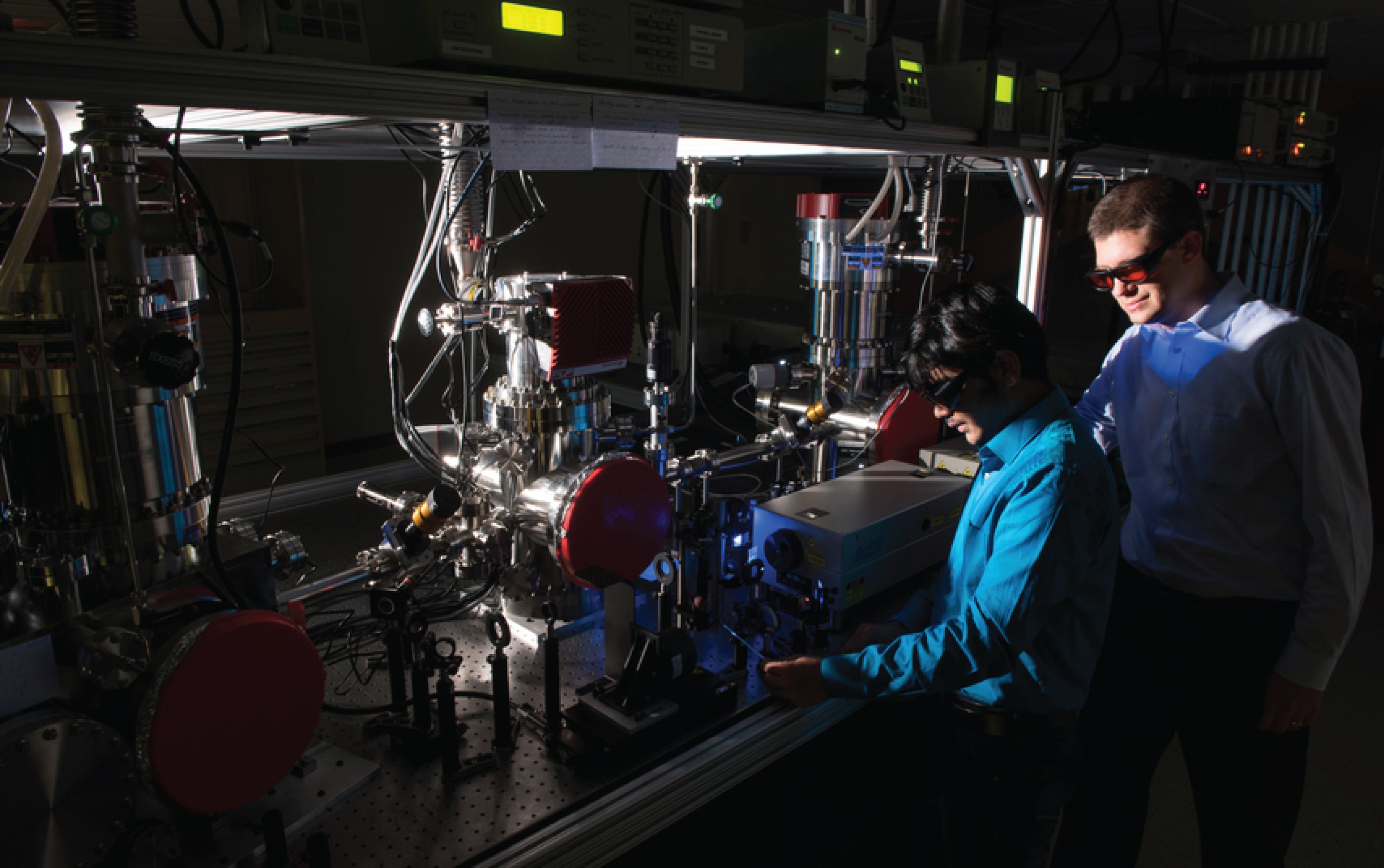
Most Recent Research Publications
Several recent papers by Baker, published in 2020, explore metal oxide chemistry and catalysis. This research continues to expand the exploration of the surface electronic behavior of metal oxides for photocatalysis using XUV reflection–absorption spectroscopy as well as plasmon-enhanced vibrational SFG spectroscopy.
Baker has used XUV reflection–absorption spectroscopy to study the surface electronic structure and carrier kinetics in photocatalytic transition metal oxides (1). Specifically, the dynamics of small polaron formation at hematite surfaces demonstrates that the rate of carrier self-trapping is slower than in the bulk because of the greater lattice reorganization energy required for surface polaron formation. Note that in condensed matter physics polarons represent the concept of quasiparticles used to understand the interactions between electrons and atoms. Although polarons exist throughout the bulk of a material, their energetics and transport properties are unique at a surface or interface, and these unique differences, although difficult to probe, govern the energy conversion efficiency of a catalytic system. Baker’s work shows that ultrafast XUV reflection–absorption spectroscopy can provide direction visualization of these important processes in real-time, leading to a better understanding of how to control charge transport properties at interfaces.
In situ, plasmon-enhanced vibrational sum frequency generation (SFG) spectroscopy was applied by Baker and colleagues to directly observe carbon dioxide electro-reduction on gold surfaces (2,3). Nonlinear interactions between IR and near-infrared (NIR) laser beams were used to observe the gold and electrolyte interface during active electrocatalysis and to show that the rate-determining step for this reaction is CO2 adsorption. It is important to note that this type of spectroscopy provides the capability for direct observation of interfacial processes that govern the surface kinetics of electrocatalysis. SFG vibrational spectroscopy is a powerful tool for observing interfaces, but applying it to in situ electrocatalysis can be a challenge. Baker showed that this can be effectively accomplished by using plasmon resonance to couple the electric fields of light through the electrode to measure low concentration intermediates at the electrode–electrolyte interface with high sensitivity (3). These findings reveal important details about how the composition and structure of the electrolyte actually controls catalytic chemistry on the electrode surface (2).
Baker and colleagues have also edited a special issue of the Journal of Chemical Physics on the topic of metal oxide chemistry and catalysis, which included both theoretical and experimental contributions from many of the leaders in this exciting area (4). Analytical methods delineated in this special issue included ambient pressure X-ray photoelectron spectroscopy (XPS), ambient pressure scanning tunneling microscopy (AP-STM), in situ X-ray diffraction (XRD), in situ vibrational spectroscopy, photoemission electron microscopy (PEEM), solid state nuclear magnetic resonance (ssNMR), Mössbauer spectroscopy, and cluster anion photoelectron spectroscopy (PES).
FIGURE 3: Baker research group at Ohio State University in 2019. Left to right: Quonsong Zhu, Harshad Gajapathy, Stephen Londo, Ananya Patnaik, Emily Hruska, Somnath Biswas, Spencer Wallentine, Meiling Spelic, L. Robert Baker, Savini Bandaranayake, and Hongyu Shang.
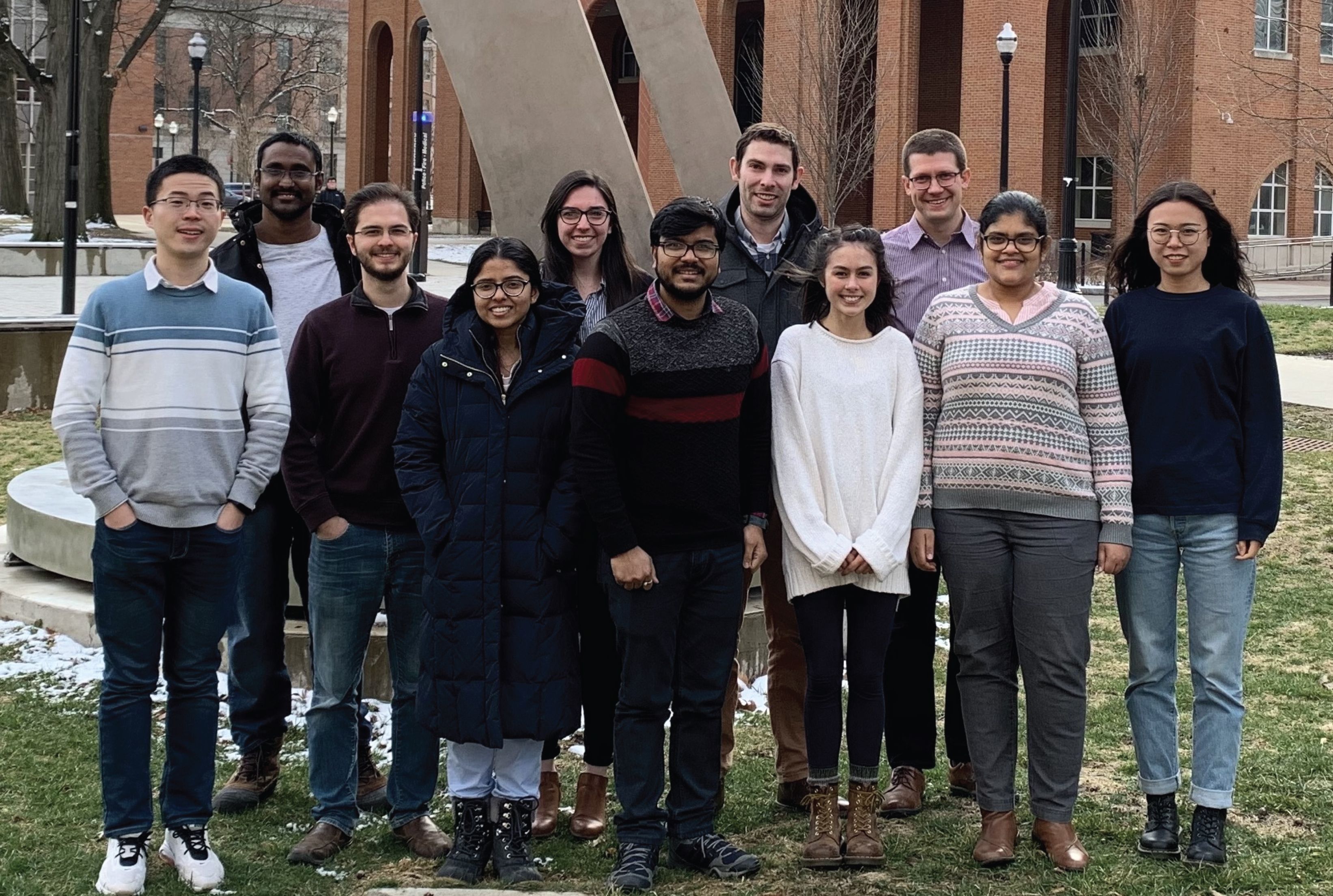
Most Recent Research Publications
Most Impactful Work to Date
In assessing Baker’s impact on the field, it is useful to look at both his mostly highly cited papers as well as those considered most important by his mentors and peers.
Key Career Publications: Most Cited
In 2015, as an assistant professor at Ohio State, Baker and coworkers published a paper reviewing the role of hot electrons and metal–oxide interfaces in surface chemistry and catalytic reactions (5), which has 201 Google Scholar (G.S.) citations. This review presents and discusses the fundamental mechanisms of energy dissipation and conversion, which occur on the material surfaces and interfaces. Technical areas studied in this review include analytical and detection methods for hot electrons and for observation of energy dissipation mechanisms. It was noted that hot electron flux is highly correlated with catalytic reaction turnover rates. It was also noted that charge transfer and ion chemistry represent one of the fundamental mechanisms of chemical activation on surfaces.
As a postdoctoral researcher at the University of California, Berkeley, in 2012, Baker used SFG vibrational spectroscopy to investigate strong metal–support interactions (SMSI) in Pt/TiO2 catalysts (6). Baker and coauthors were the first researchers to report the use of SFG to study oxide–metal interfaces during catalytic reactions and have accumulated 173 G.S. citations to date. The results of this study demonstrated that charge transfer from the TiO2 support in a Pt/TiO2 catalyst occurs by an acid–base mechanism, and this charge transfer controls the reaction yield and selectivity of furfuraldehyde hydrogenation.
In 2014, as a continuation of other SFG vibrational spectroscopy studies carried out at Berkeley, Baker and colleagues performed studies of crotonaldehyde hydrogenation in the presence of supported platinum nanoparticles (7). This paper, with 93 G.S. citations, further demonstrated how to determine the interaction between supported platinum nanoparticles, which controls the catalytic performance of Pt/TiO2 and Pt/SiO2 catalysts. The study indicated that a unique reaction pathway was identified for Pt/TiO2, which selectively produces the desired product, crotyl alcohol.
In a 2011 Nano Letters publication, Baker and coworkers used plasma fluorine insertion to generate highly n-type titanium oxide (8). Such a true demonstration of the n-type doping of titanium oxide, which precludes formation of midgap states, would allow expansion of the use of metal oxides for charge-based devices, such as re-programmable logic devices and reconfigurable built-in memory for computers.
FIGURE 4: Members of the Baker research group present at the International Symposium on Molecular Spectroscopy at University of Illinois, Urbana-Champaign in 2019. Left to right: Savini Bandaranayake, Emily Hruska, Elizabeth Fugate, Spencer Wallentine, Stephen Londo, Somnath Biswas, and L. Robert Baker.
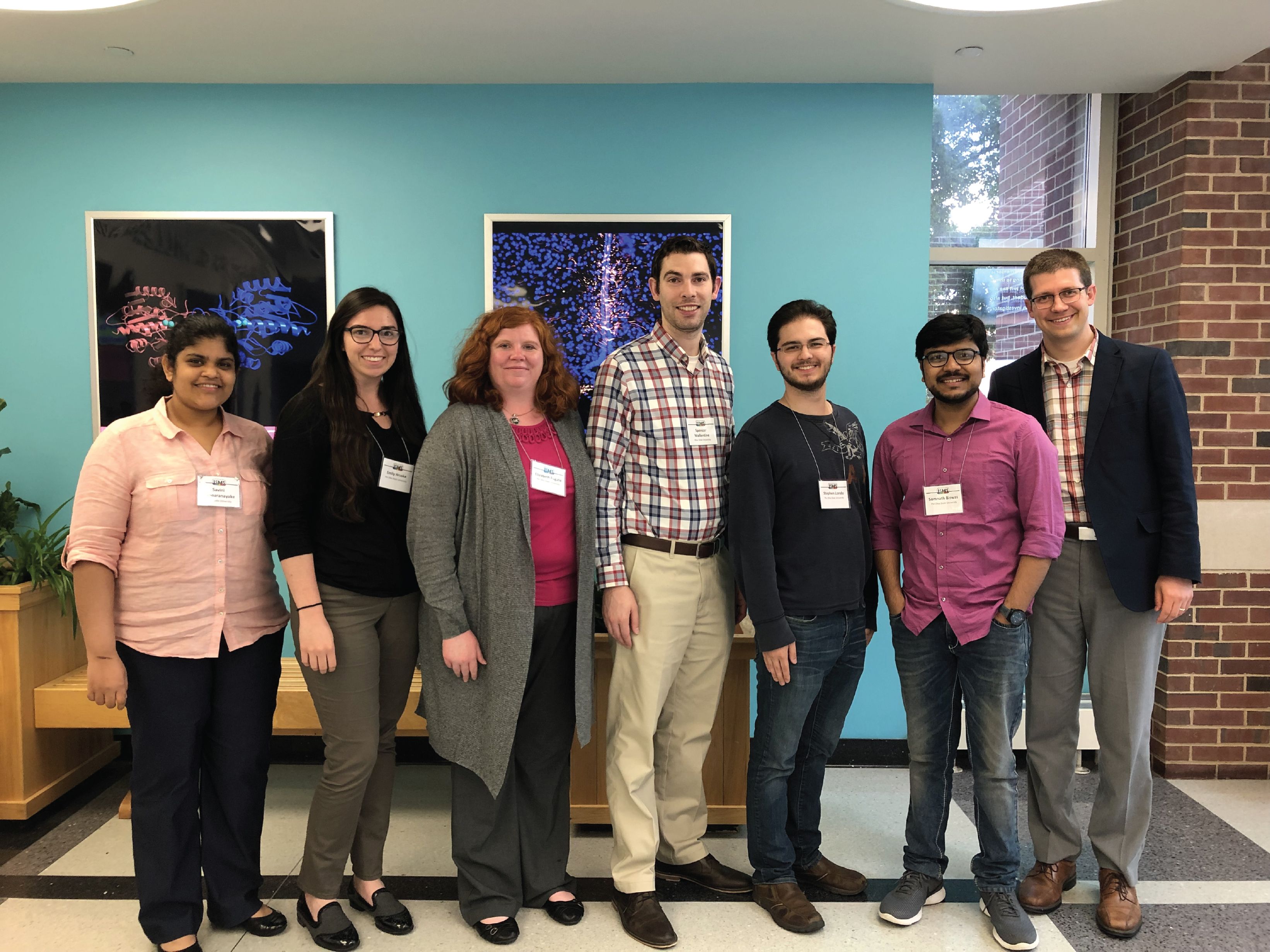
Work Named by Mentors and Peers
Baker’s nomination for this award, made in 2018, cited several publications, five of which are highlighted below. These studies, from 2017 through 2018, focused on multiple aspects of physical chemistry, chemical physics, and engineering.
As mentioned above, one of Baker’s key achievements to date has been his development of the analytical technique of near grazing-angle XUV reflection–absorption (XUV-RA) spectroscopy, specifically for the study of electron dynamics (9). This technique is capable of measuring transient oxidation state changes in real-time, with surface sensitivity, and with element-specific resolution.
Baker and colleagues applied ultrafast XUV reflection–absorption spectroscopy to demonstrate that surface charge localization and small polaron formation in hematite (α-Fe2O3) occur via a highly correlated process (10). This research provides information that may enable improvements in the modification and potential utilization of earth-abundant resources for more efficient and practical solar energy panels.
Using femtosecond XUV reflection–absorption spectroscopy, Baker and coworkers directly observed the formation of photoexcited electrons and holes in the photocatalytic materials—hematite (Fe2O3), cobalt (II,III) oxide (CO3O4), and nickel(II) oxide (NiO) (11). The ability to observe charge localization in these materials on an ultrafast time scale (femtoseconds) may demonstrate correlations between excited state electronic structure and photochemical energy conversion, which are essential properties for understanding and applying these metal oxides as photocatalysts.2O3), cobalt (II,III) oxide (CO3O4), and nickel(II) oxide (NiO) (11). The ability to observe charge localization in these materials on an ultrafast time scale (femtoseconds) may demonstrate correlations between excited state electronic structure and photochemical energy conversion, which are essential properties for understanding and applying these metal oxides as photocatalysts.
Another potential naturally occurring photocatalytic material, delafossite, is a copper iron oxide mineral with the formula CuFeO2. Baker and colleagues investigated the potential of using this metal oxide as a solar photocathode for carbon dioxide conversion. By using XUV reflection–absorption and optical spectroscopy in combination with density functional theory (DFT) calculations (12), this research was able to track the element-specific electron and hole dynamics in CuFeO2 and compare its photocatalytic properties, as a solar photocathode, to those for Iron (III) oxide (Fe2O3).
Nickel(II) oxide (NiO) is a standard material used for solar energy devices. In solar panels, a photoactive layer performs light absorption, which is followed by a charge separation facilitated by a NiO hole collection layer. Baker prepared a model hole injection structure by depositing a thin layer of NiO on an Fe2O3 substrate. Then by using XUV-RA spectroscopy, the detailed dynamics of exciton dissociation and hole injection into NiO was studied (13).
FIGURE 5: Baker as a graduate student in Gabor Somorjai’s laboratory at University of California, Berkeley in 2011. Shown in the background is the hot electron nanodiode reactor.
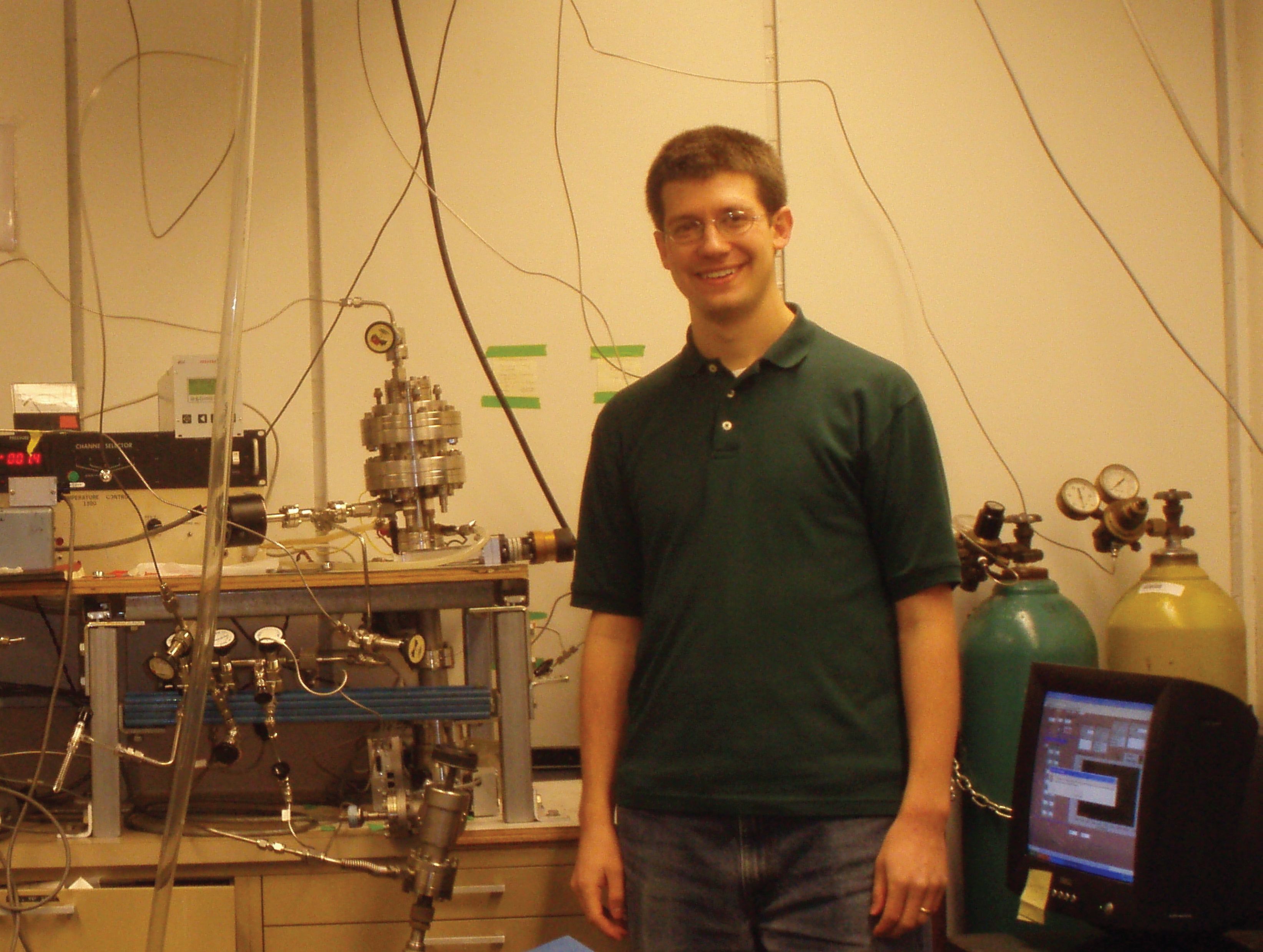
A Brilliant Student and Emerging Leader
Numerous collaborators and mentors have praised Baker’s academic work and scholarship—noting he achieved a cumulative grade point average of 4.0 in all of his graduate studies, and has published multiple high impact research papers.
“Robert Baker was one of my most brilliant graduate students,” said Professor Somorjai. “Baker’s specialty fields are spectroscopy, surface chemistry, and catalysis. He is an excellent spectroscopist and the combination of all these fields will assure that he will be the discoverer of many important chemical phenomena.”
Heather Allen is the Dow Professor and an Ohio State Distinguished Scholar at The Ohio State University. She was impressed with Baker when she first met him during his interview at the university in 2013.
“I feel a special appreciation for Robert in that I know what a treasure he is in so many ways in addition to his intellect, and his strong ethic,” Allen said. “For me, it is too early to say what his legacy will be; however, he is firing on all cylinders and in multiple directions such that he is already making his mark in a number of research areas.”
Louis DiMauro, a professor of physics at The Ohio State University and the co-Director of the National Science Foundation (NSF) NeXUS facility with Baker, has been working with Baker for almost 5 years. His first meeting with Baker also had an impact.
“I was immensely impressed by Robert’s maturity,” DiMauro said. “This was the beginning of an enjoyable collaboration.” DiMauro believes “Baker will become a leader in ultrafast X-ray science and will continue to develop and exploit XUV absorption–reflectivity spectroscopy for material science.”
Scott Cushing is an assistant professor at the California Institute of Technology (Caltech) and has now known Baker for three years. As a postdoctoral researcher, Cushing had worked with a transient XUV system that Robert had helped to pioneer. Now, the two work together closely in the field of transient XUV spectroscopy, particularly as it relates to polarons and solid state photodynamics. Considering Baker’s greatest contributions, Cushing noted that Baker proved that transient extreme ultraviolet (XUV) spectroscopy is a critical tool in understanding the photodynamics of transition metal containing solids.
“He has provided new insights into everything from charge transport in junctions, to surface chemistry, to polaron dynamics by the technique he helped to create,” Cushing said.
“Professor Baker is an emerging star in his field,” said Susan V. Olesik, the Dean of Natural and Mathematical Sciences at The Ohio State University. Olesik continued to describe Baker’s work toward the development of tabletop X-ray spectroscopy as an extremely challenging experimental endeavor. “He has not only succeeded at developing this novel experimental capability, but he has pioneered the application of this method for the study of electron dynamics at surfaces within the first five years of his career. Given his early success in this area, Robert is on the arc of a career that will help to define and establish the field of surface photochemical dynamics.”
Paul S. Cremer agrees. Cremer is the J. Lloyd Huck Chair in Natural Sciences at Penn State University and an associate editor for the Journal of the American Chemical Society.
“Professor Baker is a rising star in the fields of physical chemistry, surface science, catalysis and spectroscopy,” he said. “Indeed, he is a brilliant young scientist.”
The National eXtreme Ultrafast Science (NeXUS) Facility
Baker is the lead principal investigator in a new NSF effort for a National eXtreme Ultrafast Science (NeXUS) Facility. This facility has plans to generate extreme ultraviolet (XUV) and soft X-ray pulses with durations from femtoseconds (1 × 10−15 s) to attoseconds (1 × 10−18 s). The NeXUS system is under development now. The facility will support experiments in time-resolved molecular imaging by laser-induced electron diffraction (LIED), attosecond science (ATTO), time-resolved X-ray absorption spectroscopy (XAS), time-resolved X-ray reflection spectroscopy (XRS), time-resolved X-ray magnetic circular dichroism (XMCD), time-resolved angle-resolved photoemission spectroscopy (ARPES), and time-resolved scanning tunneling microscopy (STM).
Colleagues noted the importance of this project.
“The NeXUS facility he is building at Ohio State is a complete game-changer for the field of XUV spectroscopy,” said Josh Vura-Weis, an associate professor of chemistry at the University of Illinois at Urbana-Champaign, who was a postdoctoral researcher together with Baker in the Berkeley Leone group. “I applaud his vision and skill to bring this to reality.”
“The NeXUS Facility is a huge commitment of time; it is selfless service to the chemistry and physics communities,” Allen added.
The Future
Given Baker’s accomplishments so far, colleagues only expect his excellent work to continue.
“Robert is already on the top of the game at Ohio State, including being the co-director of the NSF-NeXUS program,” said Cushing. He believes that the next- generation X-ray source Baker is working on will allow him to extend X-ray spectroscopy to many new fields.
Vura-Weis agrees, “He will continue to open up exciting new applications of advanced spectroscopic techniques.”
“Robert is already a major force in spectroscopy,” Allen said. “His trajectory is plotted to cross important thresholds in catalysis and in surface characterization.
“He doesn’t need any help being successful in my view as he has what it takes,” she concluded. “His academic trajectory is nothing but up.”
References
(1) S. Bandaranayake, E. Hruska, S. Londo, S. Biswas, and L.R. Baker, SJ. Phys. Chem. C 124(42), 22853–22870 (2020).
(2) S. Wallentine, S. Bandaranayake, S. Biswas, and L.R. Baker, J. Phys. Chem. Lett. 11(19), 8307–8313 (2020).
(3) S. Wallentine, S. Bandaranayake, S. Biswas, and L.R. Baker, J. Phys. Chem. A 124(39), 8057–8064 (2020).
(4) L.R. Baker, U. Diebold, J.Y. Park, and A. Selloni, J. Chem. Phys. 153, 050401 (2020). doi.org/10.1063/5.0021819.
(5) J.Y. Park, L.R. Baker, and G.A. Somorjai, Chem. Rev. 115(8), 2781–2817 (2015).
(6) L.R. Baker, G. Kennedy, M.Van Spronsen, A. Hervier, X. Cai, S. Chen, L.W. Wang, and G.A. Somorjai, J. Am. Chem. Soc. 134(34), 14208–14216 (2012).
(7) G. Kennedy, L.R. Baker, and G.A. Somorjai, Angew. Chem. 126(13), 3473–3476 (2014).
(8) H. Seo, L.R. Baker, A. Hervier, J. Kim, J.L. Whitten, and G.A. Somorjai, Nano Lett. 11(2), 751–756 (2011).
(9) A. Cirri, J. Husek, S. Biswas, and L.R. Baker, J. Phys. Chem. C 121(29), 15861–15869 (2017).
(10) J. Husek, A. Cirri, S. Biswas, and L.R. Baker, Chem. Sci. 8(12), 8170–8178 (2017).
(11) S. Biswas, J. Husek, S. Londo, and L.R. Baker, Nano Lett. 18(2), 1228–1233 (2018).
(12) J. Husek, A. Cirri, S. Biswas, and L.R. Baker, J. Phys. Chem. C 122(21), 11300–11304 (2018).
(13) S. Biswas, J. Husek, S. Londo, E.A. Fugate, and L.R. Baker, Phys. Chem. Chem. Phys. 20(38), 24545–24552 (2018).
Jerome Workman, Jr. is Senior Technical Editor for Spectroscopy. Direct correspondence about this article to: jworkman@mjhlifesciences.com ●
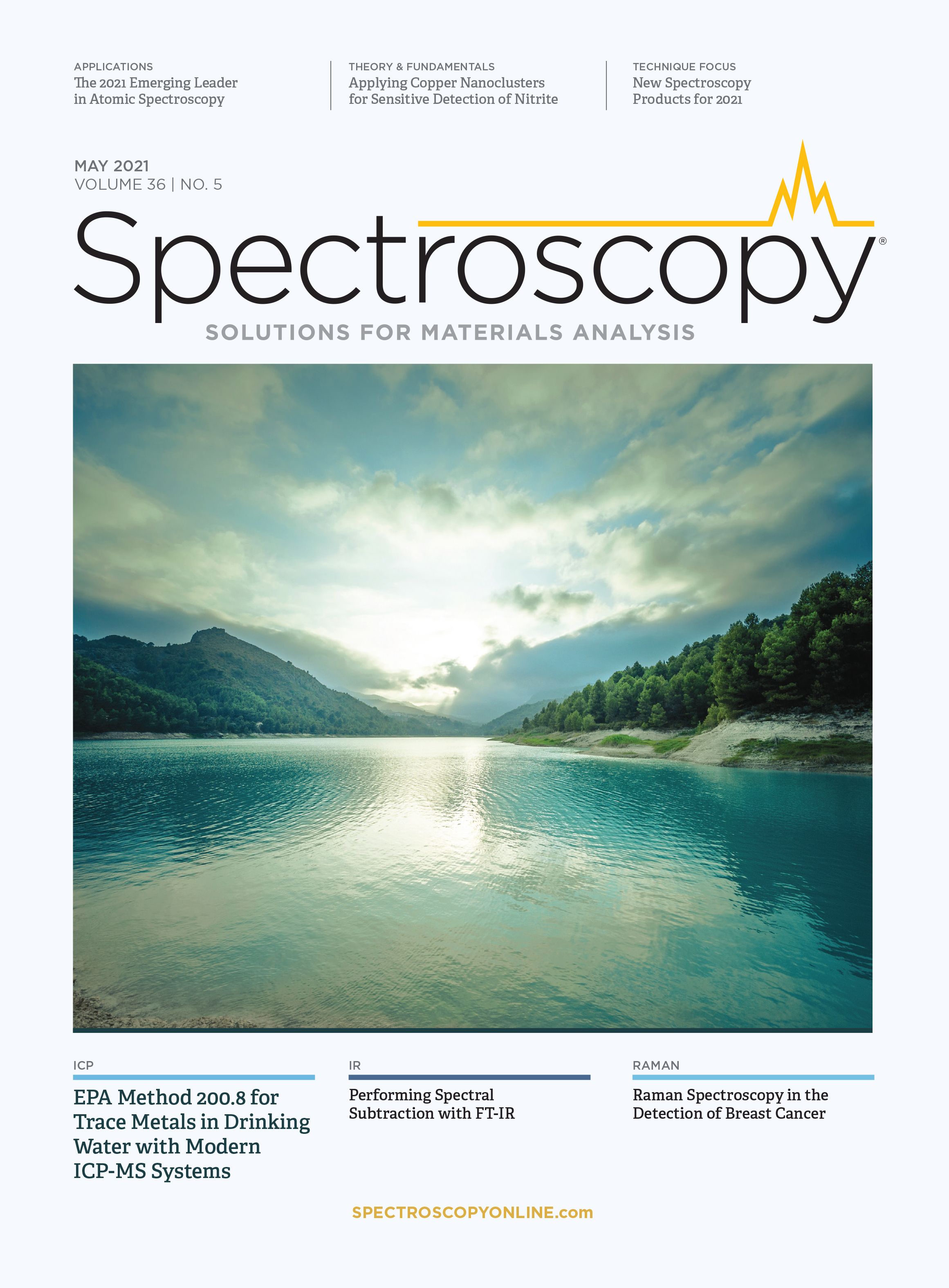
Atomic Perspectives: Highlights from Recent Columns
March 3rd 2025“Atomic Perspectives,” provides tutorials and updates on new analytical atomic spectroscopy techniques in a broad range of applications, including environmental analysis, food and beverage analysis, and space exploration, to name a few. Here, we present a compilation of some of the most popular columns.
Pittcon 2025: Highlighting Talks on Atomic Spectroscopy
February 26th 2025At Pittcon this year, there will be numerous sessions dedicated to spotlighting the latest research that uses atomic spectroscopy or elemental analysis techniques. We highlight some of these talks below that might pique the interest of spectroscopists and researchers attending the conference this year.